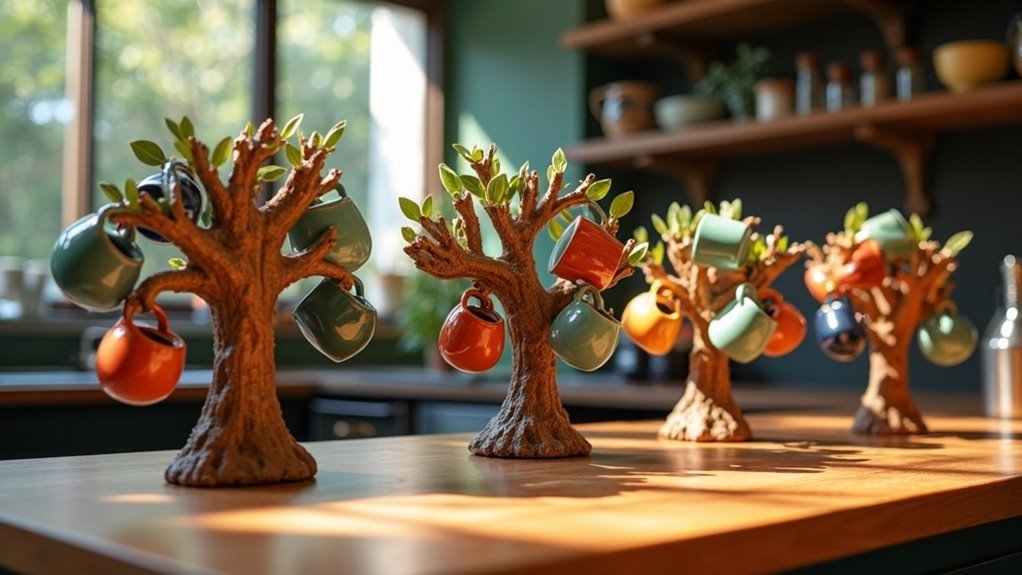Castillo coffee is a revolutionary varietal developed in Colombia in 2005 to combat coffee leaf rust. This unique varietal combines the genetics of Caturra and Timor Hybrid, resulting in higher yields and exceptional quality. Known for its smoothness and bright citric acidity, Castillo coffee produces complex flavor profiles that can score over 90 points in cupping. Its resilience not only appeals to environmentally conscious consumers but also benefits farmers who are looking for sustainable options. To fully appreciate the impact of Castillo coffee, consider exploring its market position and the advantages it offers to both producers and coffee lovers.
Key Takeaways
- Castillo Coffee is a coffee varietal that originated in Colombia, designed to combat coffee leaf rust through the crossbreeding of Caturra and Timor Hybrid.
- This varietal represents about 40% of Colombia’s coffee production and is renowned for its high yield and resilience to diseases.
- Its flavor profile is characterized by a smooth texture, citric acidity, and delightful notes of ripe red apples, brown sugar, and fresh raspberries.
- To maintain its vibrant fruit characteristics and enhance its aromatic qualities, Castillo Coffee is typically roasted to a light or medium level.
- For farmers, it provides significant economic advantages, including increased yields, lower fungicide costs, and improved market prices for specialty-grade coffee.
A Brief History of Castillo Coffee
Castillo coffee emerged in 2005 as a pivotal innovation in Colombia’s coffee industry, specifically developed to address the severe impacts of coffee leaf rust.
This hybrid variety was created by Cenicafé through the crossbreeding of Caturra and the Timor Hybrid over five generations of genetic improvement research.
Prior to the introduction of Castillo, the Caturra variety dominated Colombian coffee crops but faced significant yield losses due to the disease.
Today, Castillo represents approximately 40% of Colombia’s coffee production, celebrated for its resilience and high yield, which facilitates dense planting.
Additionally, it’s recognized for its ability to produce high-quality specialty coffee, with some samples achieving scores above 90.
Characteristics of Castillo Coffee
When exploring the characteristics of Castillo coffee, you’ll discover its smoothness, enticing aroma, and distinct citric acidity as standout features.
This resilient variety, developed for sustainability, thrives in diverse climates, enhancing its adaptability. Castillo coffee typically scores high in cupping, often exceeding 90 points, comparable to other Colombian coffee varieties like Caturra.
Its genetic diversity contributes to a range of flavors while maintaining resilience against diseases, particularly coffee leaf rust.
Roasted between light and medium, Castillo coffee preserves its vibrant, fruity components, resulting in a clean, balanced cup that showcases notes of red apples, brown sugar, and floral hints.
Tasting Notes and Flavor Profile
The tasting notes and flavor profile of Castillo coffee present an enticing fusion of sweetness and acidity that delights a diverse array of coffee lovers.
Its smooth texture paired with bright citric acidity creates a harmonious experience, appealing to both espresso aficionados and fans of milk-based beverages.
Here’s what you can expect:
- Flavors reminiscent of ripe red apples
- Notes of rich brown sugar
- Hints of fresh raspberries
- Subtle floral undertones
- Lively aromatic qualities
When roasted to a light to medium level, Castillo coffee enhances its fruity characteristics, resulting in a clean and vibrant cup.
It often garners high cupping scores, establishing it as an exceptional choice for those who appreciate quality coffee.
Roasting Castillo Coffee
Roasting Castillo coffee is an art that requires a careful balance of temperature and time to bring out its unique flavor characteristics.
Typically roasted to a light to medium profile, this method enhances the coffee’s fruity notes, resulting in a smooth and well-rounded cup. The roasting process plays a significant role in flavor development; light roasts highlight the coffee’s acidity and sweetness, while medium roasts introduce a richer depth.
Ensuring consistent quality during roasting is crucial, as it allows Castillo coffee to shine in cupping evaluations, often achieving scores of 90 or higher.
Coffee growers value its distinctive attributes; however, Castillo’s uniformity can pose challenges in blind tastings, reflecting the high-quality standards maintained across various growing regions.
The Position of Castillo Coffee in the Market
As Castillo coffee continues to dominate Colombia’s agricultural landscape, accounting for 40% of the country’s coffee crops, its market position has evolved considerably.
This varietal is increasingly recognized in specialty coffee circles, often surpassing the quality of other varieties, with some samples achieving impressive cupping scores of 90+. Its adaptability to various climates enhances its appeal, while sustainable farming practices attract eco-conscious consumers.
Key factors shaping Castillo coffee’s market position include:
- Unique flavor profiles that entice coffee enthusiasts
- High cupping scores reflecting exceptional quality
- Commitment to environmental sustainability
- Reduced fungicide use promoting healthier farming
- An expanding presence in specialty coffee markets
This evolution illustrates a significant shift in Colombia’s coffee landscape, positioning Castillo coffee as a leader in both quality and environmental responsibility.
Disease Resistance and Environmental Impact
The rise of Castillo coffee in specialty markets goes beyond its exceptional flavor and quality; it also represents significant advancements in disease resistance and environmental impact. This unique varietal is specifically bred to resist coffee leaf rust, a disease that can severely damage coffee crops. By minimizing the reliance on fungicides, Castillo coffee encourages sustainable farming practices and reduces production costs for farmers. The table below outlines these advantages:
| Feature | Castillo Coffee | Traditional Varietals |
|---|---|---|
| Disease Resistance | High | Low |
| Fungicide Requirement | None | Required |
| Environmental Impact | Positive | Negative |
| Production Costs | Lower | Higher |
| Ecosystem Health | Improved | Deteriorated |
This progress not only benefits the farmers but also contributes to a healthier ecosystem, making Castillo coffee a responsible choice for environmentally conscious consumers.
Economic Benefits for Farmers
Farmers can experience significant economic benefits from cultivating Castillo coffee, as this varietal consistently produces higher yields compared to traditional options.
The advantages include:
- Increased production resulting in larger harvests of premium coffee beans
- Reduced fungicide costs due to coffee leaf rust resistance, leading to healthier crops
- Higher market prices for specialty-grade coffee, enhancing profitability
- Enhanced sustainability appealing to environmentally conscious consumers who value quality coffee
- Adaptability to diverse climates, ensuring resilience and consistent quality in coffee production
Future Challenges and Preemptive Measures
While the Castillo coffee varietal has shown resilience against certain threats, the future of coffee production remains precarious due to emerging challenges like climate change and pest pressures.
Rising temperatures threaten Arabica yields and increase vulnerability to diseases such as coffee leaf rust.
The National Coffee Research Centre (Cenicafé) is proactively addressing these risks by developing new coffee varieties with enhanced resistance to biotic and abiotic stresses, including drought and soil acidity.
Continuous research is essential to integrate new genetic traits into future cultivars, ensuring that Castillo remains a robust option capable of withstanding evolving disease threats like coffee berry disease.








